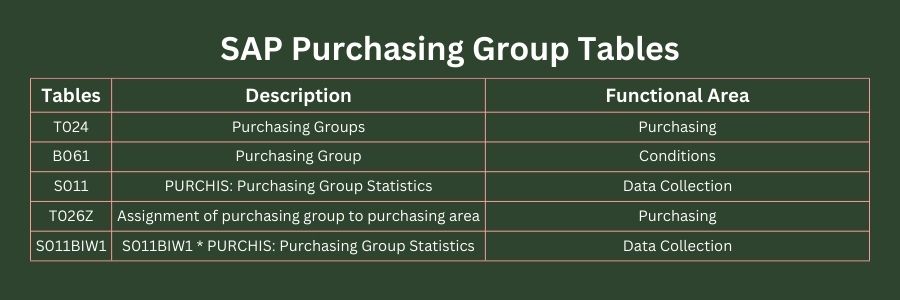SAP Purchasing Group Tables play very elementary role in the system to enhance the efficiency of the ERP system. The function of the tables is to streamline the purchasing activities within the organization. They reside the information concerning to the purchasing logically. Below in tabular form, details of purchasing tables are given:
| Table | Descriptions | Functional Area |
| T024 | Purchasing Groups | Purchasing |
| B061 | Purchasing Group | Conditions |
| S011 | PURCHIS: Purchasing Group Statistics | Data Collection |
| T026Z | Assignment of purchasing group to purchasing area | Purchasing |
| S011BIW1 | S011BIW1 * PURCHIS: Purchasing Group Statistics | Data Collection |
| S011BIW2 | S011BIW2 * PURCHIS: Purchasing Group | Statistics Data Collection |
T024 Tables
Description: These tables hold data about purchasing groups comprising of assigned codes, description and related data. The prominent fields of the tables are EBGRP (Purchasing Group),EKGRP (Purchasing Group Descriptions) and more
T024E Table
Description: The SAP Purchasing Group Table is part of database for assignment of purchasing organizations. Tables hold information about assignment of purchasing groups to purchasing organizations having fields EKORG (Purchasing Organization), EKGRP (Purchasing Group) and more
T024W Table
Description: This table holds information about the purchasing organizations valid for related purchasing groups. The fields of the table are EBGRP (Purchasing Organization), EBGRP (Purchasing Group) and more
T061 Tables
Description: It is table in SD application with the transaction code SE16 and SE11 TCode. Its fields are MANDT,KAPPL , KSCHL , EKGRP and more
T16FB Table
Description: It is part of SAP ERP System with the function to select the field selection for purchasing groups in the vender master record.
In Short SAP Purchasing Group Tables are mandatory part of SAP Material Management Module (MM). Moreover, this set of tables deliver an organized and structured framework for organization of purchasing groups , their assignments and concerning procurement processes. The function of these tables is to facilitate effective procurement operations, compliance and control within the organizations, ultimately being a part of effective supply chain management.


